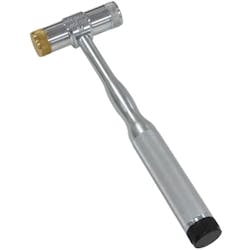Tool Review: Magna-Matic Defense Precision Steel Dead-Blow Hammer
The review
A hammer is a standard tool in any shop, but issues arise with most hammers when working in tight quarters or when working with fragile parts and components. Phil Fournier, owner of Phil’s Auto Clinic in Hemet, California, says the Magna-Matic Defense Precision Steel Dead-Blow Hammer, No. PSDB1, is ideal for those situations.
“The dead blow hammer is light duty but allows for more ‘bang’ in tight places,” Fournier says. “Most dead blow hammers are quite large, and this one lets you do effective tapping in close quarters.”
Around his shop, Fournier used the lightweight hammer for a variety of maintenance jobs, including tapping in grease or oil seals. He also used the hammer when installing a coolant fitting and pipe on a Ford 6.7 Power Stroke turbocharger.
“There is just very little room to work [on the turbocharger] and the tool [needed for the installations] – a Jiffy-Tite connector – has to be pushed in to lift the retaining clip away from the line,” he says. “A light tapping was required to insert the [Jiffy-Tite connector] fully so as to release the clip, and [the Precision Steel Dead-Blow Hammer] did the job admirably.”
While working with the hammer, Fournier was impressed with “the small profile and interchangeable hammer faces.” He found that the three different faces of the hammer worked well for delicate work requiring light hammering and noted that the hammer didn’t cause any damage to fragile parts or components during maintenance.
“[The hammer is] very good for tapping in fragile grease or oil seals, especially on front-wheel drive transverse engines where there is very little room to work between the shock tower and the engine,” he says.
Though Fournier liked the precision hammer, he did feel it could be improved by replacing the magnet in the end cap with a rare earth super magnet.
“The [magnet] … will pick up the odd lightweight screw, but [not much] more than that.”
Fournier also mentions that the hammer’s price may be a bit much for some technicians, but “its value in tight spaces may make it worth the money for some,” he says.
However, Fournier still found the hammer to be useful in a tight spot.
“The precision nature of the little dead-blow hammer makes it quite a nice addition to a tool set,” he says.
The product
The Magna-Matic Defense Precision Steel Dead-Blow Hammer, No. PSDB1, is an all-steel precision CNC machined hammer. The PSDB1 can have three different hammer tip materials “on-board” - one can be screwed into each side of the hammerhead and the third screws into the bottom of the handle. No matter what type of pin or against what finish you might have to hit, you can pick a hard or soft non-marring hammer tip for the job. The tips are held tight with large o-rings, so they’ll never back-off and come loose. The dead-blow design of the hammer incorporates a solid steel slug (rather than sand in most dead-blow hammers), this provides you with a kinetic transfer of energy that multiplies your hitting force. If you have a job where light gentle tapping is required, you can remove the steel slug and store it in the handle of the PSDB1. The various curves in the handle allow for numerous choked up hand positions for lighter tapping or a full handle grip for maximum force. The end of the handle isn’t just a clever storage area for the steel slug, when not in use, since there is the third hammer tip on the end of the handle, you can produce a very light, gentle tapping force with the end of the handle. The PSDB1 Hammer includes the hammer body/handle, one brass tip, one hardened steel tip, one delrin (plastic) tip, and one steel dead-blow slug.
About the Author
Emily Markham
Editor | PTEN and Professional Distributor
Emily Markham is the editor of Professional Tool & Equipment News (PTEN) and Professional Distributor magazines. She has been writing about the automotive aftermarket since 2019, after graduating from UW-La Crosse with a bachelor's degree in English. During her first three years with EndeavorB2B's Vehicle Service & Repair Group, Markham also wrote for Fleet Maintenance magazine.
Don't miss Markham's next article. Sign up for PTEN or Professional Distributor's weekly newsletter.

